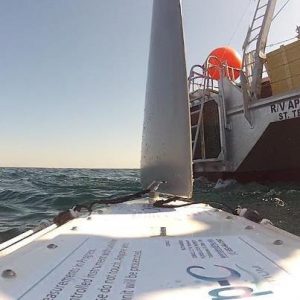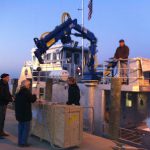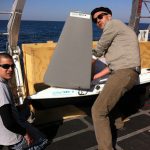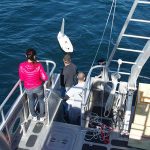Deep-C Launches the Gulf’s First SailBuoy for Scientific Observations
– April 3, 2013
Think of a surfboard-sized water version of an Unmanned Aerial Vehicle and you have the SailBuoy.
The self-powered, wind-propelled, autonomously-controlled vessel advances the way that scientists gather and transmit oceanic and atmospheric data. With its two-way communications and ability to make observations over extended periods of time in all types of weather and at low cost, researchers can use the data it collects in a wide variety of ocean applications – from taking measurements to tracking oil spills to acting as a communication relay station for underwater instruments.
“A typical drifter buoy deployed around the De Soto Canyon would move out of the area within a few days. What makes the SailBuoy extremely valuable to our research is that we can sustain observations for days, weeks, months or even longer from the same location. We can navigate and change its location remotely from our Operations Center.” – Dr. Lars Hole, Norwegian Meteorological Institute
Dr. Lars Hole with the Norwegian Meteorological Institute and Dr. Nico Wienders with Florida State University lead the SailBuoy Project for the Deep Sea to Coast Connectivity in the Eastern Gulf of (Deep-C) consortium. In mid-March, Dr. Wienders and his team launched the SailBuoy from the RV Apalachee. In this first-time use of the SailBuoy in the Gulf, it will crisscross the northeastern Gulf of Mexico over the next two months gathering and transmitting data on salinity, temperature, and oxygen in the DeSoto canyon region. Researchers specifically selected this time period, known as “spring bloom”, in order to capture conditions when hypoxia is typically at its worst. This information will help scientists better understand the interactions between the Mississippi River plume and currents in the De Soto Canyon, both of which affected how oil moved from the Deepwater Horizon oil spill site to coastal shorelines.
- (Click to enlarge)
- (Click to enlarge)
- (Click to enlarge)
Mr. David Peddie and his research team with CMR Instrumentation in Bergen, Norway designed the SailBuoy. CMR’s technology environment traces its roots back to 1930, as part of the Chr. Michelsen Institute (CMI). CMI was established to provide free and independent research, as a result of a bequest from former prime minister and ship-owner Christian Michelsen.
Learn more about this project at the Deep-C SailBuoy Project site which includes a tracking map of the buoy’s locations and read about its journey at the Deep-C SailBuoy Blog. For vessel specifications, read the SailBuoy Datasheet.
This research is made possible by a grant from BP/The Gulf of Mexico Research Initiative. The GoMRI is a 10-year, $500 million independent research program established by an agreement between BP and the Gulf of Mexico Alliance to study the effects of the Deepwater Horizon incident and the potential associated impact of this and similar incidents on the environment and public health.
© Copyright 2010- 2017 Gulf of Mexico Research Initiative (GoMRI) – All Rights Reserved. Redistribution is encouraged with acknowledgement to the Gulf of Mexico Research Initiative (GoMRI). Please credit images and/or videos as done in each article. Questions? Contact web-content editor Nilde “Maggie” Dannreuther, Northern Gulf Institute, Mississippi State University (maggied@ngi.msstate.edu).









